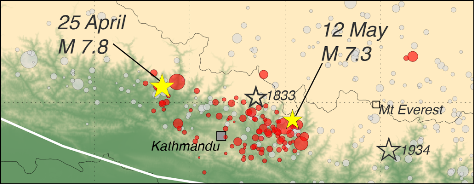GUEST BLOG: Nepal – give don’t go. It might be just as compassionate
by - 15th May 2015
 Map of 25 April Nepal quake and aftershocks courtesy USGS. For further details, see this USGS page.
Map of 25 April Nepal quake and aftershocks courtesy USGS. For further details, see this USGS page.
YESTERDAY'S Guardian online comments page featured a piece urging restraint when it comes to volunteering in disaster zones.
In her article, Claire Bennett entreats all those well meaning but ill-equipped and largely unskilled volunteers not to rush to Nepal on the first available plane.
She is right, of course: good intentions leading to ill-considered actions often do more harm than good.
She finishes her article by reminding us that the best thing we can do is give money, making sure that whatever charity we donate through delivers the funds to the people who need them most.
The problem with the piece is that for all its timely good sense and salutary warnings about the difficulties which lie ahead for those who venture to Nepalin order to give practical assistance, it is disempowering.
Of course we can all give money, but is that all we can give?
What about the enormous reserves of human compassion which we all share but which we often don’t know how to deploy?
How and where are they to be channelled effectively?
This is where a proper understanding of religion is helpful.
The word ‘religion’ comes from the Latin ‘ligare’ which means to bind together.
It holds goodness together and allows it to ‘leaven the dough’ of our collective human experience.
It does this by bringing to bear what is good in human thought and human desire on situations where there is great suffering.
Whengood variants of religious practice are functioning in a healthy way, that compassion will be worked into whatever situation requires it and effect positive change.
The work of compassion takes place simultaneously on two, or possibly three levels, the active, the spiritual and through the giving of alms.
Almsgiving, or donating money, is only one part of the threefold work of compassion.
All people of good faith, when it is understood in its religious sense, will live out compassion to a greater or lesser extent on each of these levels, depending on their personal gifts and circumstances.
But each of these areas of compassion contribute to the re-building of lives.
Alms, or donations, rebuild infrastructure.
More direct giving, such as the ShelterBox project, which is sponsored by the Rotary Club, provides emergency shelter and supplies for Nepal as well as for other devastated regions.
Sponsorship with its underwriting of compassionate projects falls into the category of the active.
The Rotary Club is a non-religious organisation but its compassionate work invites others (those who give) to become part of its compassionate action.
This is also where the spiritual, or religious, dimension binds everything together. When it comes to the work of compassion, the terms spiritual and religious are coterminous with acting and giving.
The donating of money, the sponsorship of children, and volunteering itself, are all sourced from the religious, or spiritual.
They derive from the inner life which makes us the persons we are.
When this spiritual life is directed through God to other people, or to any sentient being, it is called prayer, or mindfulness.
Many would also call it love.
©Lorraine Cavanagh
Two ways to donate:
ShelterBox works with the Nepalese Red Cross
WeHelpNepal directly supports locally-led, peer-to-peer Nepal Earthquake relief efforts
